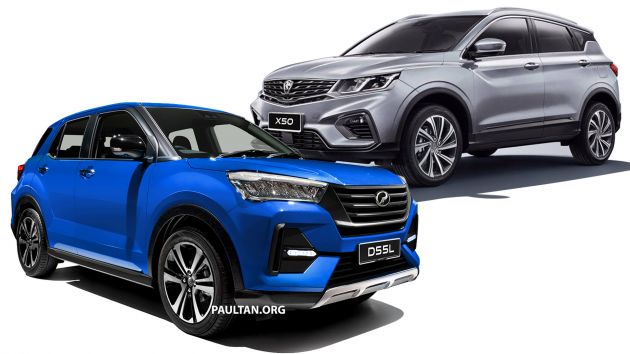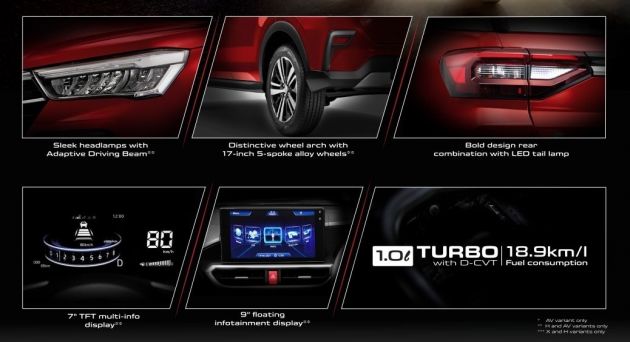Now that we have the official name, pricing and key details of the upcoming Perodua Ativa D55L SUV, the internet has gone wild, really. There’s plenty of discussions or rather, arguments regarding Perodua Ativa versus the Proton X50.
That’s to be expected of course, there are a lot of questions out there. Should you really compare these two models to each other? Are they even in the same class or market? Should you cancel your X50 booking for the Perodua? What is the deal here? The answer is really quite complicated, so let’s talk about it.
First of all, I do agree that this is not a fair apple-to-apple comparison. The price range is the most significant factor here. The Perodua is priced between RM62k and RM73k, while the Proton goes for RM79k to over RM100k. There’s no overlap here, and crucially the most expensive Ativa is still significantly more affordable than the cheapest X50. So, you might think that these cars have completely different target markets, no one is going to be cross shopping between the two, so perhaps any comparisons are not relevant at all.
But here, I’d have to disagree. Of course you should be comparing the two. Car buyers should always look around, see what’s available in the market, not just zero in on one brand and buy it straight away.
Yes, there’s no overlap, but think about it. If you’re a guy who is sitting on a booking of the X50 Standard, waiting for your allocation, and now there’s a new option in the market. If you get the Ativa AV instead, you can save some money, get better safety features and yes, probably get the car earlier at this rate.


Same goes for those who are looking at the X50 Flagship because, you know, you really want your next car to have advanced driver assist systems (ADAS), for example. Now, there’s a much cheaper option that meets your criteria.
And it goes both ways too. Those considering the Ativa should definitely go out and test drive the X50 too. Now, I haven’t driven the new Perodua yet, but I think it’s safe to assume the Proton will have a big advantage in terms of performance and of course, ride and handling. Life isn’t all about specs and numbers after all, the subjective things sometimes matter so much more.
And if, like me, you’re hooked on the Proton’s looks and driving dynamics, you might want to consider spending that little bit more for the X50. My point is, it’s always good to consider all your options, and comparing the two are 100% relevant.
Now let’s talk about the size difference, because this is pretty significant too. The Ativa is clearly smaller than the X50, and even though it’s marketed here as a compact B-segment SUV, in some markets the Daihatsu Rocky is even considered as an A-segment SUV. The Proton is a proper B-segment SUV.
But at this point, do classes or segments even matter anymore? The Aruz is technically a B-segment SUV too, but you wouldn’t compare it to these two, right? Looking at dimensions, the X50 is over 300 mm longer and 100 mm wider than the Ativa. The Proton also has a much longer wheelbase – 75 mm longer, to be exact. That’s a lot.
But as usual, pure numbers don’t always tell the whole story. My colleagues who have seen the Daihatsu Rocky all say that it’s pretty big inside. I haven’t been in one myself, but I would guess that the Perodua SUV will be at least as spacious the X50 inside. And we already know for a fact the Rocky has a bigger boot than the Proton.
It’s a similar story if you look at the Perodua Axia and Proton Iriz too. The A-segment Axia is obviously smaller than the B-segment Iriz, but actually it’s the Axia that has a more spacious cabin and a bigger boot. Exterior size can be misleading.
So what is my point then? Those of you who are completely dismissing any comparisons just because the X50 is bigger, or the Ativa is a lot smaller, I don’t think that’s fair. I’ve seen people saying “oh, the Perodua is too small, sure cramped inside. Cannot lah.” That’s just not right.
But I get it, though. Size does matter, sometimes. The X50 does look bigger on the road, carrying more road presence and prestige, sure. It looks like the more expensive car, and of course it is. If that matters to you, sure, I can’t argue with that. Just remember, always consider all your options.
Next, let’s move on to engines. Both models have a downsized three-cylinder turbo engine. So all of you who questioned Proton’s use of a three-pot in the X50, now Perodua has joined the party too.


But beyond having the same layout, the two engines are so, so different. The Perodua Ativa gets a 1.0 litre turbo with multi-point injection, and it’s basically the same 1.0 litre engine already used in the Axia and Bezza, just that it’s turbocharged now. Hence the T suffix in the 1KR-VET engine code.
The Proton, meanwhile, has a bigger 1.5 litre turbo engine, and the Flagship version has direct injection too. It’s also clearly a far more modern, more advanced engine seeing that it’s shared with the Volvo XC40, following the premium brand’s very high standards.
That’s clear to see by looking at the power outputs too. The Perodua’s 1.0 litre turbo makes 98 PS and 140 Nm of torque, compared to 177 PS and 255 Nm for the direct-injection X50 Flagship. So, the Proton engine is 50% bigger, but makes 80% more power and torque.
At the same time though, you do have to consider that the X50 weighs 400 kg, or 40% more than the Perodua, so the D55L will have an edge in term of fuel economy. Perodua claims a fuel consumption figure of 5.3 l/100 km vs 6.4 litres for the X50.
As for refinement and engine vibration, I sure hope the Ativa is a huge improvement over the same engines in the Axia and Bezza. If not, then that will be a massive advantage for the X50.
The Ativa also uses a CVT compared to the Proton’s dual-clutch transmission, so the driving experience will be very different between the two. CVT is a thing that you either love or hate, so we’ll see if the Perodua CVT is any good. If it’s anything like the ones in Toyotas, it will be about a million times better than Proton’s Punch CVTs.
But still, I find it interesting how Perodua is adopting both turbocharging and CVT for the first time here – two things that a lot of Perodua fanboys have made fun of with Protons as being expensive to maintain and with the CVT, no fun to drive. Well, at least they will still have the timing chain to shout about.
Moving on to safety, Perodua has pulled an absolute stunner here with the Ativa. Autonomous emergency braking (AEB) is standard on all models, motorcycle detection, Adaptive Cruise Control, Level 2 semi-autonomous driving – it’s incredible that you can have all that for around RM70k.
I remember not too long ago that we called out Perodua for not having basic safety features like extra airbags and electronic stability control and now, the brand is setting new industry standards. Well done, Perodua, well done indeed.
The Ativa’s safety features put the X50 to shame. Here we have AEB on all variants, while Proton insists on taking airbags out from the X50 Standard. AEB is only available on the top-spec X50 Flagship at over RM100k, which may have been fine a year or two ago, but now with the Ativa and the new Nissan Almera, the game has moved on. The new Perodua will have Level 2 semi-autonomous driving features too, matching the X50, but at a much lower entry price.
The one thing the Proton has over the Perodua is Auto Park Assist, which as I’ve mentioned many times over, is really not that useful. It’s slow, and if you really can’t do simple parking manoeuvres, I would suggest this app called Grab. The Daihatsu Rocky actually does have an auto park feature, but we’re assuming Perodua has skipped it, since there are no mentions of it in the official details. But, we could be wrong on this one.
Now let’s talk about rebadging for a minute. Both of these cars are basically rebadged versions of other cars. The Ativa is based on the Daihatsu Rocky, and the X50 is the same as the Geely Binyue.
Before you cry foul, saying the Malaysian car industry has regressed, both local car companies really have done quite a fair bit of work here. Perodua claims to have been involved in the design and development of the Daihatsu Rocky, with 30 Perodua employees based in Japan. That’s why it looks so much like the Myvi, because Perodua had a hand in designing it.
As for the X50, Proton led the R&D work in converting it to right hand drive, and the local engineers have completely transformed its ride and handling characteristics to better suit Malaysian roads. I dare say the Proton X50 now is a better car than the Geely Binyue because of it. And yeah, Proton designed the grille too, of course.
So that’s about it for this video. A not-so-short discussion on comparing the upcoming Perodua Ativa D55L versus the Proton X50. Long story short, these two cars are not exactly natural rivals to each other.


It’s not like how the Mercedes-Benz C-Class is a direct rival to the BMW 3 Series, exactly same kind of car, bang on in terms of size, similar pricing, and so on.
But that shouldn’t stop you from comparing them anyway, because as I’ve explained, if you’re looking to buy one of these models, you should at least consider the other one too. Having options is never a bad thing.
At the same time, as online commenters or industry observers, you should not force your own personal preference on others. Just because you prefer one brand over the other, doesn’t mean others must agree with you. Different people have different tastes and preference, guys.
Me, most of you know I have a Proton X50 Flagship myself, and having looked at the specs, I think I would have considered the Perodua as an alternative. I’m not saying I would have gotten the Ativa instead, not likely because I love the way the X50 drives, but I would have at least given the Perodua a chance.
Just, keep an open mind, people, and be nice to each other. Nobody likes extreme fanboys, so don’t be one. If you’ve made it this far, do let me know what you think of this video, whether you agree or disagree with my views. I’d love to read your comments. Thanks for watching, and stay safe, everyone.
The post VIDEO: Perodua Ativa D55L SUV versus Proton X50 appeared first on Paul Tan's Automotive News.





0 Comments